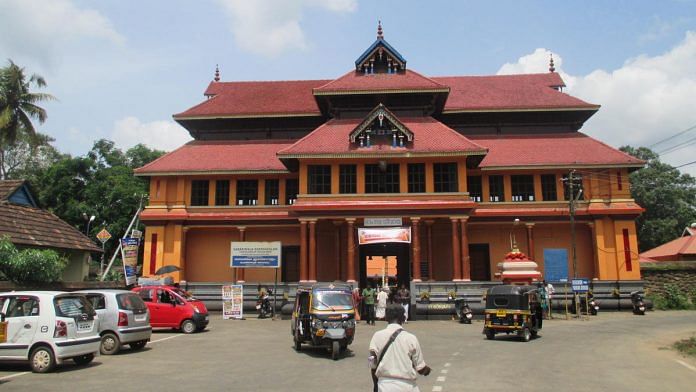The Chengannur Mahadeva Kshetram is located in Kerala’s Alappuzha district, which neighbours Pathanamthitta, where Sabarimala temple is situated.
Bengaluru: The Sabarimala temple in Kerala’s Pathanamthitta has been in the eye of a storm over devotees’ refusal to let women of the menstruating age (10-50 years) inside the sanctum sanctorum of Lord Ayyappa, its reigning deity.
But in the neighbouring district of Alappuzha, menstruation and its distinctive red stain are celebrated at a temple dedicated to Lord Shiva and Parvati.
Devotees who visit the Chengannur Mahadeva Kshetram believe that the idol of Lord Shiva’s wife Parvati installed there menstruates.
The discovery of the stain involves a well-established routine that culminates in festivities, including a dance by women hoping for divine blessings for a happy married life.
However, while the temple is unique in its celebration of menstruation, it still toes the line that guides entry to all Hindu shrines: Women on their period are not allowed inside.
Among oldest Kerala temples
The Chengannur Mahadeva Kshetram is believed to be one of the oldest temples in Kerala, built around 300 AD. Shiva and Parvati are the main deities of this temple.
In 1714, the temple was almost reduced to ashes in a fire. Uliyannoor Perumthachan, the famous architect of those times, is said to have predicted the fire and come to the temple with a new panchaloha (mix of gold, silver, copper, iron and tin) idol of Parvati to replace the one destroyed.
A lot of different stories are cited to explain honour menstruation.
Legend has it that, soon after marriage, Shiva and Parvati were told by Lord Brahma to pay their respects to sage Agastya, who is believed to have been residing in the area where the temple is built. When the newlyweds arrived, the story goes, Parvati came of age (menarche).
“When a girl achieves puberty, it is celebrated with much fanfare in our society,” said historian and researcher Unnikrishnan Nair.
“That is why this temple is dedicated to that very moment when Parvati attained hers.”
Another account suggests that Lord Shiva cut up the corpse of his first wife, Sati Devi, into several pieces and scattered them all over the country. It is believed that her abdominal region, which includes the uterus, fell in Chengannur, and this is why she menstruates at this temple.
Parvati is believed to be the reincarnation of Sati.
Also read: The religious significance of the 18 steps at Sabarimala temple
First sighting
It is not known exactly when the blood was first observed. But those familiar with the temple say the tradition began with a chance discovery of a chief priest.
It is said that the then chief priest of the temple had discovered the goddess menstruating when he opened the sanctum one day to offer fresh flowers.
He is believed to have taken the idol’s stained clothing to the senior womenfolk of two local houses, Vanchi Puzhathu Madom and Thazhaman Pothy, and both confirmed the stain was indeed from menstruation blood. The word of the matriarch of Thazhamon Pothy was taken as the final verdict and the tradition continues to this day.
It is believed that it was she who advised the priest to move the deity to another temple on the premises for three days from the first sighting of the blood and perform puja.
As time passed, it is said, the staining began to occur regularly, with the matriarch continuing to hold the final word on ruling it menstrual blood.
An elaborate affair
The festival built around Parvati’s menstruation is known as “Thriputharrattu”, a four-day affair that starts with the first sighting of blood and concludes with ‘aarattu’, or cleansing of the idol.
When the chief priest spots the stain, as tradition holds, he takes the piece of clothing to the elderly women of the Thazhamon Madom, which is his residence.
When the matriarch confirms it as menstrual blood, the temple authorities close the sanctum of the goddess. This is when a second idol is opened to devotees in another room, known as the “Thriputhu room”, for worship.
On the third day of the festival, the women of the local Pattaru community perform the Thiruvathira, a dance form of Kerala where women seek blessings from gods and goddesses for eternal marital bliss.
On the final day, the idol of Parvati is taken in a procession to the Pamba river on an elephant.
Amid elaborate puja and chanting, the deity is brought back in a procession along with thousands of devotees who wait for the final step — circling the temple thrice — after which Parvati is reunited with Shiva.
According to Nair, the udayada (the goddess’ stained garment) used to be auctioned to devotees as an object of worship.
Chengannur resident Pramod P.K. said the ritual was stopped after astrologers advised the chief priest that the clothing should be destroyed soon after the confirmation of menstruation.
A matter of faith
But the obvious question remains: How do they find blood on the deity’s clothing? Nair attributes it to faith.
“It is our belief and we have seen it with our own eyes,” he said. “[Asking such questions] is like asking people who have visited temples, mosques and churches whether they have really seen god,” he added. “The answer will be no.”
When asked about the dichotomy in beliefs between the temples at Sabarimala and Chengannur, he said it was the beauty of Kerala’s culture.
“That’s how vibrant our society is,” he added. “In Chengannur, we celebrate it. That is what diversity is about and we are proud of our cultural roots.”
Also read: Another Sabarimala-like crisis is brewing in Kerala



